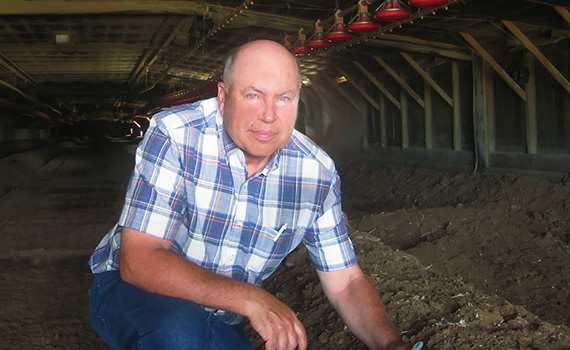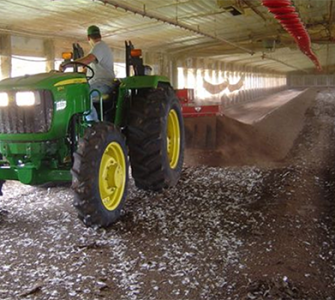Proper windrowing can minimize disease, benefit environmental management
By George W. Malone, MS
Malone Poultry Consulting
Princess Anne, Maryland
Windrow composting of litter between flocks has been used in the commercial broiler and turkey industries since the 1980s. It’s still evolving in response to emerging challenges, such as the trend toward raising flocks without antibiotics.
Windrowing is simply the timely stacking of litter into properly sized piles to initiate biological heating action. With proper conditions, litter temperatures increase rapidly and reduce bacteria, viruses and insect pressure.
Back in 1987, I conducted a small-scale broiler study with windrowed litter, which at the time was also called litter “pasteurization.” The results indicated that chicks placed on composted litter started better and had better total weight gain than chicks placed on fresh bedding or on used litter that wasn’t composted.
Years later, there was a growing interest in this alternative litter-management technology among the Delmarva poultry industry due to concern about the availability and cost of bedding, as well as some health problems confronting flocks in the region.
In early field trails, there were some failures but also successes with windrowing. One Delmarva farm with respiratory-disease problems was able to improve performance and reduce production costs by about 1 cent per pound, a success that eventually led the company to implement windrowing at all of its contract farms.
When a Mississippi broiler complex started windrowing in 1999, it experienced a 0.7 cents-per-pound improvement in cost and attributed the success to fewer pathogens, particularly a decreased coccidial challenge.
Helps control disease
Over the years, there’s been a lot of research on this litter-management technique. Research along with field observations1 have shown that windrowing litter between flocks is a successful strategy for reducing or eliminating Escherichia coli, Staphylococcus, Salmonella, Aspergillus, respiratory viruses, Clostridium perfringens and coccidia.
Windrowing has also been a successful intervention for dermatitis, necrotic enteritis, and runting and stunting syndrome. Combined with timely insecticide treatment, windrowing can decrease the darkling beetle population to near zero.
Even though windrowing has shown the greatest benefit on poor-performing farms, it can be helpful in many other situations. This would include farms raising flocks without antibiotics, small-bird programs, farms with high disease challenges, farms in areas where bedding material is inadequate or expensive and those facing increased environmental scrutiny on waste management.
For some farms with disease problems, windrowing after every flock can be beneficial, but others with less serious issues may consider windrowing as a maintenance program done several times a year.
Cause of windrowing failures
During early adoption of this technology and even today, there have been failures and, occasionally, negative results with windrowing. In my experience, most failures occur when there is inadequate knowledge about how to properly windrow and when there are inadequate resources or commitment to the process. The most significant factor leading to failure has been inadequate litter-moisture management and ammonia control.
The first Delmarva farm to windrow used litter had a near disaster due to excessive ammonia. Interestingly, years later, when this same producer faced significant performance challenges, he started windrowing again, but by then, he had a better understanding of the process and improved his cost of production by about 2 cents per pound.
When windrowing was first implemented in the Delmarva region, the need for a clear set of procedural guidelines and documentation of the science behind windrowing recommendations became very apparent. As the poultry specialist at the University of Delaware Extension, I had the opportunity to conduct applied research and worked with numerous poultry companies, producers and windrowing-equipment manufactures to develop and validate the guidelines.
We learned a lot from these early observations and from many others across the country on proper implementation procedures — and we’re continuing to learn as this litter-management tool evolves. The intent of this article is not to detail windrowing procedures since they can be found elsewhere.2 Instead, I want to share some examples of key lessons learned about this litter-management technique.
How to avoid excessive ammonia
To avoid excessive ammonia issues when disrupting a used litter base, it’s best to start a windrowing program during warm or moderate weather. This way, higher ventilation and litter-amendment rates can be used to deal with the initial burst of ammonia. Ammonia in subsequent flocks tends to be more manageable if other guidelines are followed.2
Some producers may skip windrowing during the coldest winter months to avoid potential ammonia challenges. In other cases, growers who have perfected the windrowing technique and have adequate downtime between flocks — about 14 days or more — can manage ammonia and moisture throughout the year, even in some of the most northern states.
Don’t give up too soon
Even with good windrowing techniques, some farms with disease challenges have discontinued the program if they haven’t seen positive results in the first flock. Keep in mind, however, that with diseases such as dermatitis, two or more consecutive windrowing flocks may be needed to break the disease cycle. In addition, the disease may reappear once windrowing is stopped.
Table 1 provides an example of one Delmarva farm with 85,000 large birds that was experiencing poor performance and high mortality due to dermatitis. With each consecutive windrowed flock, the incidence of dermatitis was delayed and decreased; by the third flock, no dermatitis was observed.
Also, darkling beetle populations (adults and larvae) were dramatically reduced (76%) with windrowing, and when combined with an insecticide (flock 3), there was near-complete control.
Most importantly, this producer’s income rose more than $100 per 1,000-bird capacity by the third flock on windrowed litter compared to the previous flock on de-caked litter.
Table 1. Windrowing results on a large-bird Delmarva farm
| Flock litter management | Flock mortality | Beetle reduction* | Income improvement (per 1,000 birds)** |
|
De-cake |
6.2% | — | — |
|
1st windrow |
4.9% |
76% |
$23 |
|
2nd windrow |
4.1% |
76% |
$89 |
| 3rd windrow | 3.2% | ˜100% |
$103 |
* Percentage reduction in larvae and adult darkling beetles recovered in traps compared to previous flock on de-caked litter. Only the third flock was treated with an insecticide for darkling beetle control.
** Increase in producer pay per 1,000-bird capacity compared to flock on de-caked litter.
Tips for success
It’s been my observation that producers with the best windrowing success excel by carefully following implementation guidelines. They closely maintain 4 to 6 inches of hardpan-free litter depth, they construct piles within a day after birds are moved and they incorporate all litter, including litter along sidewalls and corners, into the piles. The piles are turned once and, if time permits, multiple times to release ammonia and moisture and to expose more of the litter mass to higher temperatures.
To ensure moisture and ammonia removal from the litter during layout, they don’t depend on natural ventilation in these solid-sidewall houses. Instead, they power-ventilate houses during the entire downtime as much as possible, given weather conditions and pre-heat schedules. Their ability to manage cake and litter moisture contributes to their success in achieving windrow temperatures exceeding 140° F while avoiding excess ammonia and wet litter in subsequent flocks.
Windrowing has also shown real value in the conservation of bedding and extending litter life. It complements the farm’s waste-management plan. In recent years, it’s become common practice among several Delmarva companies to encourage windrowing for the first two flocks following a total cleanout. Not only does this help condition the litter for better ammonia control, it contributes to an important and rapid build-up of the litter base.
To avoid removing excessive amounts of quality bedding when de-caking the first several flocks, all litter (including the cake) is windrowed. After piles are leveled, the litter is pulverized or re-crusted with a de-caking machine. In subsequent windrowed flocks, the volume of cake removed generally decreases, in part because deep litter is more forgiving for moisture management.
Because litter tends to accumulate at a faster rate with windrowing, a portion of the litter needs to be periodically removed at certain times of the year — often spring and/or fall — to meet both production goals and waste/nutrient-management plans.
There’s one producer in the Delmarva region raising conventional flocks who has above-average results with windrowing. He participated in one of our windrowing trials in 2008 and has continued to windrow the same litter without replacing or adding any supplemental bedding. He manages his litter depth and excels in his windrowing procedures.
It’s true that on some well-managed farms growing conventional birds that have little disease pressure, the health and performance benefits of windrowing may be marginal. On farms with less than ideal flock health and performance, however, the cost of a properly executed windrowing program is more than offset by the added income. Proper windrowing can potentially reduce the coccidial and bacterial challenge. It’s proving to be a useful disease-suppression strategy that can complement systems growing birds without antibiotics. Windrowing is also an important tool for environmental management.
To achieve a favorable return on the cost of windrowing, the most important and critical factor is careful adherence to recommended windrowing guidelines.
Malone is a retired poultry specialist from the University of Delaware Cooperative Extension.
Editor’s note: The opinions and advice presented in this article belong to the author and, as such, are presented here as points of view, not specific recommendations by Poultry Health Today.
1 Malone G, Marsh-Johnson T. A Practical Guide for Managing Risk in Poultry Production 2nd Edition. AAAP, Inc. 2017;191-228.
2 Malone G. Windrowing Properly Done. Zootecnica International. 2017 March;50-53.
Posted on October 1, 2017

















